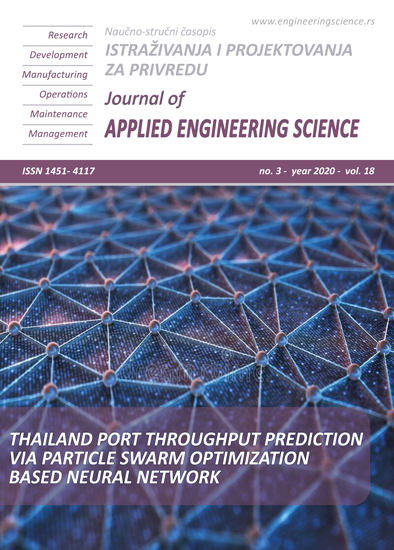RESEARCH OF WAYS OF CONNECTING REINFORCED BARS IN THE PRODUCTION OF REINFORCED CONCRETE PRODUCTS
Abstract
The authors conduct research on the creation of non-waste technology for the use of reinforcing bars in the manufacture of reinforced concrete products (reinforced concrete). This article presents the results of a study of existing methods for connecting reinforcing bars in the manufacture of reinforced concrete. The connection methods were investigated: mechanical, lap welded. Their advantages and disadvantages are revealed. Welding methods have also been investigated: contact, bathroom docking, contact spot, friction welding. The following main disadvantages inherent in existing methods of connecting reinforcing bars were established: the narrowness of technological capabilities, low quality and accuracy of the connection, the high cost of technological equipment. To address these shortcomings, a new method of friction welding for connecting reinforcing bars is proposed.
References
[Electronic resource] http://okarkase.ru/strojmaterialy/soedinenie-armatury-svarkoj-vidy-preimushhestva-gost.html#vidy-soedineniya-armatury
[Electronic resource] http://fb.ru/article/343558/sposobyi-svarki-armaturyi
Setkov, V.I., Serbii, E.P., (2005), Building Constructions: Textbook. - 2nd ed., sup. and rev. - M.: INFRA-M.- 448 p.
Tsai, T.N., (2012), Building Constructions. Reinforced Concrete Structures: Textbook. 3rd ed. - SPb: Publishing House “Lan”. - 464 p.
Mulin, N.M., (1990), Rod Reinforcement of Reinforced Concrete Structures. - M.: Stroyizdat.– 233p.
Baikov, V.N., Sigalov, E.E., (1991), Reinforced Concrete Structures: General course: Textbook for universities. – 5th ed., and sup. - M: Stroyizdat. – 767 p.
Sherov, К.Т., Sikhimbaev, M.R., Sherov, A.K., Mazdubay, A.V., Rakishev A.K., [et al.], (2017), Matematical modeling of thermofrictional milling process using ANSYS WB software // Journal of Theoretical and Applied Mechanics, Sofia, Vol. 47, No. 2, pp.24-33.
Sherov, K.T., Baizhabaginova, G.A., Gurba, G., Imasheva, K.I., [et al.], (2010), Friction Welding is a Promising Direction of Thermofriction Technology of Working and Joining Parts (overview-1) // Scientific works of M. Auezov SKSU. - Shymkent: Publishing House "Nurly Beine",.-№2 (20) .- P.96-103.
Sherov, K.T., Gurba, G., Imasheva, K.I., Bykova, N.A., (2010), Friction Welding is a Promising Direction of Thermofriction Technology of Working and Joining Parts (overview-2) // Science Bulletin of S. Seifullin Kazakh Agro Technical University.- Astana: KazAU Publishing House.-№4 (66) - P. 133-138.
Sherov, K.T., Boyarski, V.G., Mussayev, M.M., [et al.], (2012), Tool for Welding a Hole in a Steel Part // Innovative patent No. 26582 of the Republic of Kazakhstan for an invention. Bul. No.12.
Sherov, K.T., (2017), Friction Tool-Rod for Welding Holes in a Steel Part // Patent No. 2183 of the Republic of Kazakhstan for a utility model. Bul. No. 10.
Sherov, K.T., Mukysh, B.B., Zhanuzakov, S.Zh., (2016), Development of a New Research Method of Friction Welding // Works of international scientific and practical conference “Integration of Science, Education and Production is the Basis for the Implementation of the Plan of the Nation” (Saginov readings No. 8), Part 3. – Karaganda: KSTU Publishing House. – P.149-151.
Sherov, K.T., Baktybai, I.S., (2019), Device for Friction Welding // Abstracts of the Republican student scientific conference “The Contribution of Youth Science to the Implementation of the “Kazakhstan-2050 Strategy”, dedicated to the 120th anniversary of K. Satpayev and the Year of Youth in the Republic of Kazakhstan. - Karaganda: KSTU Publishing Рouse. – P.652-653.
Esirkepova A.B., Sherov, K.T., (2019), The Use of Measuring Wastes of a Rebar in the Production of Reinforced Concrete Products // Works of international scientific and practical conference “Integration of Science, Education and Production is the Basis for the Implementation of the Plan of the Nation” (Saginov readings No. 11), Part 4. – Karaganda: KSTU Publishing House. – P.363-365.

